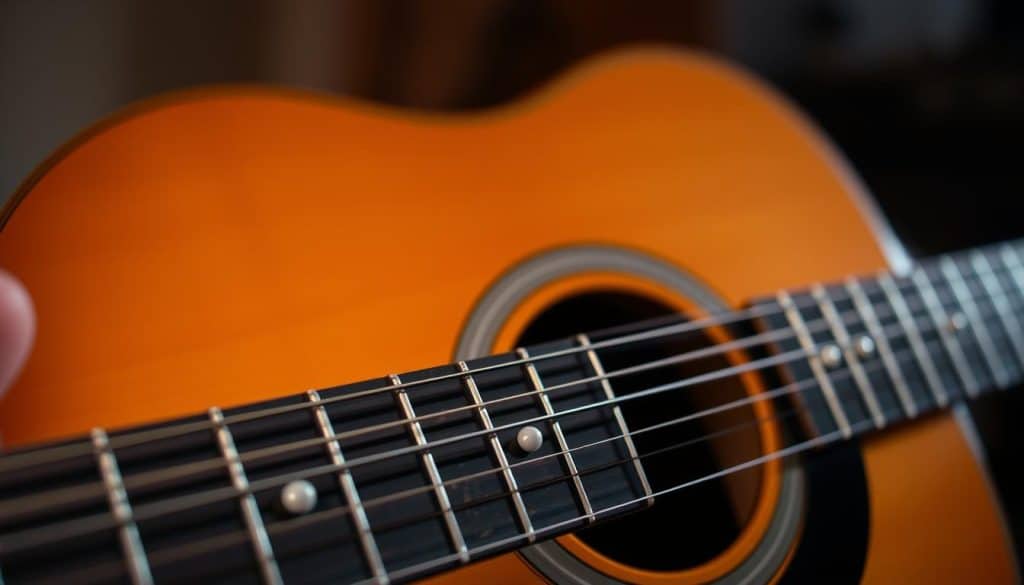Did you know mastering the G chord can really boost your music journey? Over 70% of popular songs use this key chord. It’s crucial for new and experienced guitarists1. Learning the G chord opens up lots of new songs across different styles.
This g chord guitar tutorial shows you how to nail this important chord. By mastering the G chord, you’ll not only get better but also widen your song choices. This chord is a core skill that boosts your flexibility as a guitarist.
Key Takeaways
- The G chord is central to many popular songs.
- Mastering the G chord enhances your musical repertoire.
- Essential for various genres, making it an important skill.
- This tutorial is designed for both beginners and experienced players.
- Learning the G chord opens up new songs and progressions.
Understanding the Basics of Guitar Chords
Learning the basics of guitar chords is key for any guitarist. A chord is a mix of two or more notes played at once. It forms the core of music. Knowing about different guitar chord structures, like major and minor, is part of mastering chord theory.
Chords are sorted by their sound. Major chords have a bright, happy sound. Minor chords sound sad. Augmented and diminished chords bring unique sounds, adding tension in music. Knowing these differences helps you understand guitar chord structure better.
Knowing chord progressions is also vital. These are chord sequences that build a song’s harmony. They add emotional depth and story to music. Learning common progressions helps you explore more chords, like the G chord.
In short, knowing the basics of guitar chords is crucial for growth. It helps you understand how different chords and progressions work together. For beginners, this knowledge is the first step to becoming great.
Look for more resources on guitar chord theory and practicing techniques. These tips will help you as you get better on your musical path2.
What Makes the G Chord Unique?
The G chord is known for its unique, bright sound. This sound makes the G chord stand out in music, especially in folk, rock, and country. It brings out strong emotions in those who listen, highlighting the chord’s importance in music.
When it comes to music, the G chord plays a key role. It supports the main melody and adds emotional depth. Its unique sound works well with other chords, creating lively and complex harmonies. This shows how flexible and popular the G chord is among musicians.
The G chord is crucial for songwriting and performing. It can lift a song to new heights and has shaped many music genres. This shows the G chord’s simple yet powerful impact on music.
g chord guitar – Your Essential Guide
Learning the G chord is key to your growth as a guitarist. It’s important to know how it works and why it matters. This knowledge will speed up your progress in music.
Overview of the G Chord
The G chord has three main notes: G, B, and D. You can play it in different ways on the guitar. The open G major chord is the most common shape. It sounds rich and full. Getting good at this chord is important. It’s used in many hit songs across styles because of its happy sound.
Importance of the G Chord in Music
The G chord is very important in music. It’s a basic chord in the key of C major. It’s used a lot in pop, rock, and folk music.
It makes your fingers more flexible, which helps you play better. This chord is used often in writing songs. It is key for making catchy tunes and harmonies. Every guitarist should learn it to get better at music.
How to Play the G Chord on Guitar
Learning to play the G chord on guitar is crucial for beginners. It’s found in many songs and gives a rich sound. This g chord tutorial will guide you through forming the chord step by step.
First, tune your guitar to standard (E A D G B e). Then, place your fingers like this:
- Index Finger: On the second fret of the A string.
- Middle Finger: On the third fret of the low E string.
- Ring Finger: On the third fret of the B string.
- Pinky Finger: On the third fret of the high E string.
Strum all six strings together. Each string should sound clear without buzzing. If any string doesn’t sound right, check your finger placements.
Learning the G chord takes practice. Doing it regularly will make your fingers more flexible and improve changing chords.
Mastering this chord opens up many songs for you. Keep at it, and with consistent practice, playing it will become easier3.
g chord guitar finger position: Step-by-Step
Getting the G chord right is key for a good sound. You need to know where to put your fingers and how to move them. Doing it right makes your playing smooth. It’s also important to know what mistakes can mess up the sound.
Proper Hand Placement
For the G chord, your fingers go on certain strings and frets. Put your index finger on the A string’s second fret. Your middle finger goes on the low E string’s third fret. Your ring finger should be on the B string’s third fret. Lastly, put your pinky on the high E string’s third fret. This way, your chord sounds full and rich. Keep your fingers curved and press evenly to avoid buzzing, a common mistake.
Avoiding Common Mistakes
Beginners often don’t put their fingers right. Not pressing the strings enough can mute the sound. Press the strings well but don’t push too hard. Another issue is putting your fingers too close to the fret. This leads to buzzing. Aim for the middle of the fret for a clear sound. To get better, check out this guide on easy guitar chords.
| Common Mistakes | Correction |
|---|---|
| Insufficient finger pressure | Apply firm pressure on strings |
| Fingers too close to the fret | Position fingers midway between frets |
| Finger overlap causing muted strings | Ensure fingers are separate and arch |
G Chord Guitar Variations to Enhance Your Playing
Learning different g chord guitar variations can really improve how you play music. Each variation has its own special sound that lets you be creative. You’ll find G major, G7, and G sus4 chords very useful.
| Chord Variation | Fingering Details | Usage in Songs |
|---|---|---|
| G Major | Put your second finger on the 3rd fret of the sixth string, first finger on the 2nd fret of the fifth string, and third finger on the 3rd fret of the first string. | It’s widely used in many songs across different styles, being a core chord. |
| G7 | Keep the G major shape but add your fourth finger on the 1st fret of the first string. | This chord’s great for blues and rock, adding a tension that resolves nicely. |
| G sus4 | Start with G major, then add your fourth finger to the 3rd fret of the second string. | It gives a dreamy sound, fitting for folk and pop music. |
Knowing these g chord guitar variations makes you a better player. It gives you different ways to write and arrange songs. Practice them well and add them to what you play to keep things fresh. Look for popular songs that use these chords for ideas. Learning these chords changes how you play and lets you discover new kinds of music.
Easy G Chord Guitar Songs to Practice
For newcomers to guitar, starting with easy G chord songs is a great idea. This approach helps you learn key techniques. Plus, it gets you comfy with the G chord. By practicing these songs, you’ll get better while enjoying tunes that highlight the G chord’s versatility.
Popular Tracks Featuring the G Chord
- “Knockin’ on Heaven’s Door” by Bob Dylan
- “Sweet Home Alabama” by Lynyrd Skynyrd
- “I’m Yours” by Jason Mraz
- “Take Me Home, Country Roads” by John Denver
- “Brown Eyed Girl” by Van Morrison
Tips for Playing Along
Ready to jam with these hits? Keep these tips in mind:
- Practice with recordings: Listening to the originals teaches you the rhythm and vibe.
- Focus on rhythm: Keeping a steady beat is key for blending with the song.
- Sustain the timing: A metronome can help you keep your timing steady.
Tips to Master the G Chord on Guitar
To master the G chord on the guitar, focus and practice hard.Use tips to master g chord to get better at it. Start by practicing slowly. This lets you pay close attention to where your fingers go. It helps you hit each strum just right.
Practicing with a metronome is also smart. It keeps your beat steady as you play, which helps with rhythm and timing. As you get better, slowly speed up. This challenges you but keeps the quality of your playing high.
Having regular practice times works best. Set a part of your day to only practice on the G chord. This method helps your hands remember the movements faster. Also, try playing along with songs you like. It makes practice fun and strengthens what you’ve learned.
Keep an eye on your progress to stay motivated. Write down every win to see how far you’ve come. If you hit a bump, look back at these tips and think of your goals.

G Chord Guitar Practice Routines for Beginners
Making a good practice plan can really help you get better at playing the G chord on the guitar. It’s important to be consistent and focus on exercises that target the G chord. Learning how to make the most of your practice time will help you get better steadily.
Daily Practice Suggestions
It’s helpful to practice every day. Try to practice for at least 30 minutes. Split your practice time into sections that focus on different skills. Here are some ways to make your practice sessions more effective:
- Warm-up: Begin with simple finger exercises to get used to your guitar.
- Scale Practice: Practice the G major scale to help build muscle memory.
- Chord Transitions: Work on moving between the G chord and other chords smoothly.
- Song Application: Play easy songs that include the G chord to make practicing fun.
Exercises to Improve Fingering
Doing exercises focused on the G chord can help improve your technique.
- Finger Drill: Concentrate on pressing each string clearly. Keep playing the G chord over and over.
- Variation Practice: Try different versions of the G chord to become more versatile.
- Strumming Patterns: Practice different strumming patterns while holding the G chord to get better at timing and rhythm.
Using these g chord guitar practice routines and tips specifically for the G chord will help you grow musically as you start your journey.
Common Challenges with the G Chord and How to Overcome Them
Many guitarists, especially those just starting out, find the challenges with g chord tough. They struggle with finger strength, moving between chords swiftly, and keeping the beat steady. Recognizing these issues is key to getting better.
To solve these overcoming g chord difficulties, you should concentrate on a few important things:
- Finger Strength: Stronger fingers mean a firmer grip and easier string pressing. Doing exercises to make your fingers nimbler will boost your playing.
- Chord Transitions: Keep practicing how to switch chords to do it faster. This cuts down the pause between chords.
- Rhythm Maintenance: A constant beat is key. Practicing with a metronome helps you find your rhythm.
Being patient is important in this learning phase. Regular practice will help you face these issues head-on. Pay attention to how you place your hands; it impacts your music. If you keep at it with a good plan, you’ll master the g chord.
| Challenge | Possible Solution |
|---|---|
| Finger Strength | Include finger strengthening drills in your practice. |
| Chord Transitions | Work on chord changes often. |
| Rhythm Maintenance | Practicing with a metronome helps keep the beat. |
If you keep working hard and follow these tips, overcoming challenges with g chord gets easier. This makes playing the guitar more fun.
Incorporating G Chord Guitar into Your Playing Style
Adding g chord guitar techniques to your play can really lift your music. It works across many styles. The G chord’s flexibility makes it important in lots of genres. Knowing how to use the G chord in various situations can make you a more versatile guitarist.
G Chord in Different Genres
The G chord shines in rock, folk, blues, and pop. In rock, it helps express strong emotions and ideas. Songs like “Sweet Child o’ Mine” use the G chord to create catchy tunes that people love. Looking into the name Susan in rock shows how this chord supports different song themes.
In folk music, the G chord is often used to tell stories and share feelings. Take “Black-Eyed Susan” by Jesse Colin Young, for example. It shows how the G chord pairs well with tales of love and hope. This chord’s popularity crosses over many music types, connecting different tunes.
For blues, the G chord brings a deeper sound. It lets guitarists play with feelings and spontaneous sounds. In classic blues, it really helps to express sadness and desire. This makes it a key part of playing blues guitar.
Getting to know g chord guitar styles can push you to try out different sounds. This exploration can really improve your music. Diving into these styles, you’ll discover creative ways to use the G chord. This can help you leave a mark on your listeners5.
Conclusion
Learning the G chord on guitar is more than just playing the correct strings. It’s a key part of your musical path. The importance of the G chord goes way beyond easy finger positions. It lets you play lots of songs and helps with moving between chords. In music, the G chord is essential. It pops up in all kinds of music styles.
Practicing the G chord will make you more confident and improve your guitar skills. Adding the G chord to your practice opens up new song possibilities. It helps you become a more skilled guitarist. So, take on this challenge and enjoy your musical journey. Your hard work will make you better at music.
If you want to get better at guitar, check out this detailed guide. Keep playing and trying new things. The G chord will help you grow as a musician6.






